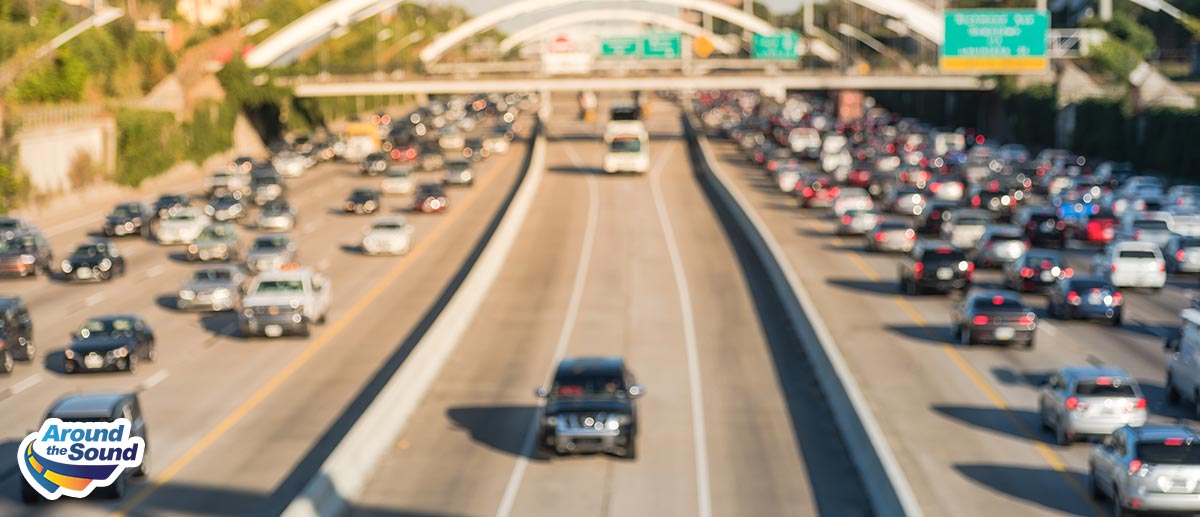
What Does HOV Stand For?
May 9, 2022 9:01 pmSeveral important highways in western Washington state have HOV lanes, lanes of traffic set aside for high-occupancy vehicles. Around the Sound uses HOV lanes to move people faster and more safely to destinations in greater Seattle and Tacoma and beyond.
What Are HOV Lanes?
High occupancy vehicle or HOV lanes are lanes of a highway that allow vehicles with more people to go down the road with less competing traffic. HOV lanes are usually set up to the left of regular traffic lanes, but sometimes they are built as elevated roadway.
HOV lanes have been a common feature on American highways for over 50 years. In 1970, the California Department of Transportation (CalTrans) opened a bypass lane at the toll plaza for the Bay Bridge linking Oakland and San Francisco.
Three years later, CalTrans opened a “busway” on the San Bernardino Freeway (I-10). This lane was originally intended just for buses, but when there was a bus drivers’ strike a year later, the highway department opened the lane to any vehicle carrying three or more passengers.
As many Around the Sound passengers will remember, the Arab oil embargo created severe gasoline shortages all over the United States. The US Department of Transportation responded by developing plans to put in HOV lanes on highways all over the country to let high-occupancy vehicles move through traffic faster, which was slowed down by a national “Drive 55” speed limit.
Over the five decades that followed, the US Department of Transportation and departments of transportation in nearly every state have devised a number of variations on the HOV lanes.
- HOV lanes can be either permanent, with concrete barriers separating them from other traffic, or temporary, marked by an overhead electronic sign and regulated on an honor system.
- HOV lanes can be concurrent, moving the same direction as the rest of traffic, or contraflow, moving in the opposite direction from the rest of traffic. Contraflow lanes are sometimes set up for mass evacuations.
- Business access and transit lanes allow anyone to enter the lane for a short distance so they can enter the driveway to a business.
- High-occupancy toll lanes give people who are driving alone the opportunity to use a high-occupancy lane by paying a toll. Usually, the driver pays the toll from a sticker transponder they place on their windshields. A scanning system either deducts the toll from the prepaid value loaded onto the sticker, or bills a credit card, or sends the driver a bill at home. Some systems recognize license plates and match them to driver toll accounts.
Which Vehicles Qualify for HOV Lanes?
Different states and provinces have different rules for who can use HOV lanes.
- The most common way to qualify for driving in an HOV lane is to have the right number of passengers. Usually that number is two or three. Babies count, but only after they are born.
- The US HOV Law makes HOV lanes available for motorcycles on any road maintained with federal funds (which is all Interstate highways and some state highways). Canada has a similar rule in British Columbia and Alberta, but not in Ontario.
- Emergency vehicles can always use HOV lanes. This includes patrol cars, ambulances, and fire trucks.
- Power company trucks can use HOV lanes when they are responding to emergency service calls.
- In the very few places bicycles are permitted on roads that have HOV lanes, they usually qualify for HOV access.
The rules also allow buses designed to be able to carry 16 or more passengers to use HOV lanes, so Around the Sound gets to use HOV lanes to get you to your destination faster.
How Do HOV Lanes Work in Washington State?
The State of Washington has HOV lanes it calls diamond lanes or carpool lanes. It also has high-occupancy toll (HOT) lanes and Express Toll lanes. These options for faster travel are found on Interstate 90, Interstate 5, State Route 520, State Route 16, and State Route 167.
The rules for HOV lanes in Washington state are complicated, and they vary from location to location.
Motorcycles always get to use HOV lanes in Washington. This is because of the federal law.
Drivers on I-405 have an option to use HOV lanes for free. They have to register for a Good to Go pass, and have the minimum number of passengers in their vehicle. However, there is a catch. The minimum number of passengers for using the HOV lane without paying a toll changes throughout the day. The busier the traffic, the more people you must have in your vehicle to avoid paying a toll.
On I-405 and State Road 167, drivers traveling alone are allowed to use the HOV lanes if they pay a toll, which is electronically transferred from the driver’s account. The system monitoring traffic lowers the toll for the HOV lane when there are fewer cars on the road and raises the toll for the HOV lane during rush hour.
State Road 167 has toll lanes that don’t charge a toll for cars with two or more passengers. For these HOV lanes, some of the rules get a little complicated. Drivers who don’t have a Good to Go pass can use the lanes for free if they have the right number of passengers in their vehicles. Drivers who do have Good to Go accounts must set their accounts to HOV mode to avoid paying a fee.
If you let Around the Sound do the driving, you don’t have to deal with any of these rules.
Around the Sound is Western Washington’s leading provider of local and regional transportation for people who have special transportation needs. We specialize in medical transportation, getting people to and from doctor’s appointments, lab work, and hospitals, but we also provide transportation for weddings, reunions, conferences, and just taking a ride around Puget Sound.
We are licensed for taking customers anywhere in Washington and surrounding states. We can accommodate wheelchairs, gurneys, and passengers with special medical needs.
Our trained, experienced, professional drivers can help you have a great trip anywhere in western Washington without the hassles of driving a car. Every trip is planned out in advance so you can make the most of your time around the Sound. Call us at (253) 858-7088 to discuss your options or Reserve a Ride Now!
Categorised in: blog, HOV Lane
This post was written by Steve Hutchins


Comments are closed here.